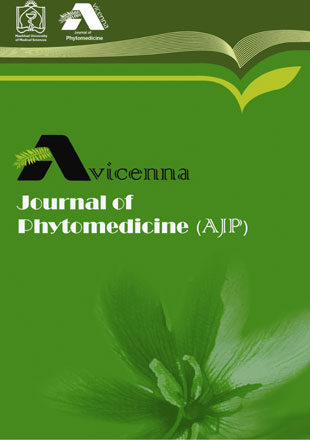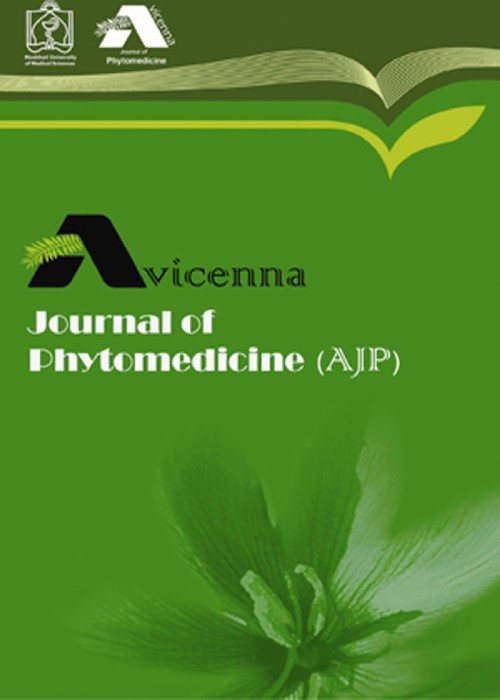فهرست مطالب

Avicenna Journal of Phytomedicine
Volume:3 Issue: 1, Winter 2013
- تاریخ انتشار: 1391/09/27
- تعداد عناوین: 10
-
-
Page 1ObjectiveMany species of plants present noticeable potency against human bacterial and fungal pathogens.Materials And MethodsIn the current study, antimicrobial activity of the fresh fruits of 4 cultivars (A to D) of Malus domestica cultivated in the Qamsar area of Kashan, Iran was investigated. The disk diffusion and minimal inhibitory concentration (MIC) evaluation antimicrobial activity tests were performed.ResultsThe samples showed moderate antimicrobial activities with inhibition zones from 11 to 16 mm in these tests. Cultivar D with inhibition zones of 16, 14, and 12 mm for E. coli, S. epidermidis and K. pneumoniae, respectively exhibited the best results in these tests. Cultivar A also showed a zone of inhibition of 11 mm against P. aerouginosa.ConclusionModerate antimicrobial activities were observed for the studied apple cultivars.Keywords: Apple, Antimicrobial, Extract, Malus domestica
-
Page 7ObjectiveThe role of herbs against the free radicals have been put forth recently in combating many diseases. The aim of this study was to elucidate the in vitro capacity and in vivo antioxidant properties of sedimental extract of Tinospora cordifolia (SETc).Materials And MethodsSETc was subjected to in vitro chemical analysis such as 1,1-diphenyl-2-picrylhydrazyl (DPPH), nitric oxide, hydrogen peroxide, and superoxide anion radicals scavenging respectively and finally drugs reductive ability in order to elucidate the antioxidant capacity of the test drug before introducing it into the biological membrane. The resulting capacity was evaluated in vivo by analyzing enzymic (SOD, CAT) and non-enzymic (vitamin C & E) antioxidant levels in the homogenized samples of major organs isolated from streptozotocin induced type 2 diabetic rats after 30th day of SETc (1000 mg/kg/p.o.) treatment. Finally, the histopathological evaluation was done using cut portion of the respective organs prone to free radical mediated cell destruction with STZ in order to study their micro anatomical changes.ResultsChemical analysis with SETc in vitro for its IC50 proves a key evident for its total antioxidant capacity of around 2046 times, in 1000 mg/kg of fixed dose per oral for in vivo analysis. In contrast to the above, the lipid peroxide levels and in vivo enzymic and non-enzymic antioxidant levels were found to possess most significant difference (p<0.001) and moderate difference (p<0.01) with diabetic non-treated animals which was an supporting contribution for those in vitro parameters studied and have proved that SETc (1000 mg/kg/p.o.) was a potent drug to elevate the antioxidants levels and further healing of damaged organs as compared with that of diabetic and standard drug treated groups.ConclusionsFinally, it was concluded that, the presence of antioxidant potentials in SETc was about 2046 time as an effective scavenger of free radicals in vitro and as a potent healer in ameliorating many signs of tissue damages in vivo in long term complicated diseases such as diabetes.Keywords: Antioxidants_Sedimental Extract of Tinospora Cordifolia (SETc)_Streptozotocin (STZ)_Type 2 Diabetes
-
Page 25ObjectivesSweet peppers Capsicum annuum L. (C. annuum) are an excellent source of vitamins A and C as well as phenolic compounds, which are important antioxidant components that may reduce the risk of diseases. The objective of this study was to evaluate their antioxidant activity under various temperatures.Materials And MethodsTo compare the antioxidant activity in various temperatures (20, 35, 50, and 65 °C), two different types of colored (red and green) sweet bell peppers C annuum were selected. The red peppers were selected from those cultivated in Shahreza, Esfahan and the green peppers with the local name of Gijlar were selected from those cultivated in Urmia, West Azarbayjan. The experiments were carried out to measure the total phenolic and flavonoid content, ferric reducing antioxidant power (FRAP), chain-breaking activity, scavenging activities of 2,2-diphenyl-1-picrylhydrazyl (DPPH), and hydrogen peroxide radicals.ResultsTotal phenol and flavonoid contents of pepper extracts were enhanced with increasing temperature to 65 °C. Scavenging capacity of DPPH radical of red pepper extract was enhanced because of putting at 50 °C for 30 min and for Gijlar pepper extract scavenging capacity was increased at 65 °C. Scavenging capacity of hydrogen peroxide radical of extracts was the highest at 35 °C. Chain-breaking activity of red pepper extract was increased for 60 min at 35 °C. FRAP (C) of red pepper extract was significantly different (p<0.05) in compare with Gijlar pepper.ConclusionAn appropriate temperature maintained a high antioxidant activity of phenolic compound, which could be due to the combined effect of non enzymatic reaction and phenolic compound stability.Keywords: Antioxidant activity, Capsicum annuum L., Phenolic extracts, Temperature
-
Page 45ObjectiveThe present study was hypothesized to investigate the beneficial effects of fresh, aged, and cooked garlic extracts on blood glucose and memory of diabetic rats induced by streptozocine (STZ).Material And MethodsDiabetes was induced by an intraperitoneal injection of STZ (60 mg/kg body weight). An oral dose of 1000 mg/kg of each garlic extract was given daily for 4 weeks after diabetes induction. Five days after STZ injection, five groups were formed: Control (intact) rats (Cont) + Vehicle of garlic extract (normal saline) (Veh), STZ + Veh, STZ + Fresh (row) garlic (FG), STZ + Aged garlic (AG), and STZ + cooked (boiled) garlic (CG). In order to assess the passive avoidance memory, rats were gently placed on the wooden platform, and latency to step-down (SDL) was recorded as initial phase, after then a light electrical shock [0.3 mA, 3 sec, Alternative current (AC)] was delivered to their foot paw. The retrieval tests were done for short- and long-term memories, respectively. Blood glucose was assayed by glucometer before and after treatment with STZ and garlic extracts.ResultsHyperglycemia induced by STZ decreased short-term memory in both diabetic males and females rats significantly compared with the controls (p<0.001 and p<0.01). Fresh and cooked but not aged garlic extracts decreased blood glucose in diabetic males and increased memory in both diabetic male and female rats significantly (p<0.05 and p<0.01).ConclusionsSTZ causes elevation of the blood glucose and resulted in memory deficits, possibly viafree radicals production in brain tissue. Garlic has some bioactive chemicals including allicin and sulfur compound (OSC) which could lower the blood glucose during chronic hyperglycemia, inhibit free radicals production in brain, and improve short-term (but not long-term) memory.Keywords: Garlic, Hyperglycemia, Memory, Rats, Streptozotocin
-
Page 56ObjectiveAsthma is an airway complex disease defined by reversible airway narrowing and obstruction, chronic airway inflammation, airway hyperresponsiveness, and tissue remodeling. The purpose of this study was to determine the effect of Brassica napus L. (B. napus) on airway pathologic changes in a rat model of asthma.Materials And MethodsTwenty-four rats were divided into 4 groups: control, asthmatic, asthmatic treated with 0.5 mg/kg B. napus oil, and asthmatic treated with 0.75 mg/kg B. napus oil. To induce the experimental asthma, rats in groups 2, 3, and 4 received an i.p. injection of ovalbumin and aerosolized ovalbumin. Simultaneously, rats in groups 3 and 4 received B. napus oil daily by gavage. After 31 days, in all groups, thoracotomy was done and lung tissue samples were taken. For pathological evaluation, microscopic slides were prepared. The eosinophil numbers in the submucosal layer and thicknesses of smooth muscle layer of bronchioles were detected.ResultsEosinophil numbers in the submucosal layer, as well as smooth muscle layer thicknesses were significantly lower in the rat group treated with 0.75 mg/kg B. napus oil as compared with asthmatic group (p<0.01, p<0.05).ConclusionB. napus could be useful as adjuvant therapy in rat model of asthma. This effect was probably related to its antioxidants components that reduce the levels of inflammatory mediators such as leukotrienes, IL-4, IL-5, and IL-13.Keywords: Airway Remodeling, Asthma, Brassica napus, Eozinophil, Inflammation, Rat, Sensitization
-
Page 82ObjectiveBarberry root extract contains various alkaloids that are considered as antioxidants. Beneficial effect of aqueous extract of Berberis integerrima root (AEBIR) was evaluated for renal function in diabetic rats induced by STZ.Material And MethodsDiabetes was induced by i.p. injection of streptozotocin (65 mg/kg bw) to rats, after 15 h of fasting. Diabetic rats were randomly grouped and treated daily with AEBIR and glibenclamide by gavage for 42 days. After 6 weeks of study, all the rats were sacrificed and some biochemical parameters of serum and urine were measured and their kidneys tissues were processed for light microscopy.ResultsStreptozotocin induced a significant rise in fasting blood glucose, serum creatinine, blood urea nitrogen, urine glucose, urine protein, urine albumin, and water intake and a significant decrease in body weight, serum protein, urine urea, and urine creatinine. There was a significant restoration of these parameters to near normal after administration of the AEBIR and also by glibenclamide (0.6 mg/kg bw). The activity of the extract at dose of 500 mg/kg in all parameters except blood glucose and urine glucose was more than that of the standard drug, glibenclamide (0.6 mg/kg, p.o.). Histopathological changes of kidney samples were comparable with respective control.ConclusionThese results suggested that aqueous extract of Berberis Integerrima root improves renal dysfunction in streptozotocin-induced diabetic rats through controlling blood glucose and renal protective effects.Keywords: Berberis integerrima, Diabetes mellitus, Renal protective, Streptozotocin
-
Page 91ObjectiveLosing weight in consequence of appetite loss can be a sign of a serious underlying condition. Currently, the most widely prescribed medication for anorexia is cyproheptadine hydrochloride. However, the clinical use of cyproheptadine hydrochloride is limited by its side effects. In Iranian traditional medicine, Coriandrum sativum stimulates the appetite. Therefore, the effect of Coriandrum sativum (coriander) hydroalcoholic extract was investigated on food intake in rats.Material And MethodsThirty male Wistar rats were randomly divided into five groups. Two control groups were used, one group received 0.5 ml water per day (vehicle group), and another group did not receive anything (control group). The other 3 groups were daily treated by 50, 100 or 150 mg/kg of coriander for 7 days, respectively. The daily amount of the food eaten by each rat was measured for 10 days. The amount of energy intake of each rat was also calculated for 7 days during the intervention. The difference in energy intake was calculated and compared between groups.ResultThere was no significant change in energy intake between control and vehicle groups. The change in energy intake after treatment by 100 and 150 mg/kg of the extract was significantly higher than other groups (p=0.030 and p=0.007)ConclusionThis study indicated that coriander had positive effects on appetite of rats. Future studies are needed to evaluate the mechanisms of the effects of this plant on appetite.Keywords: Coriandrum sativum, Appetite, Energy intake, Rat


